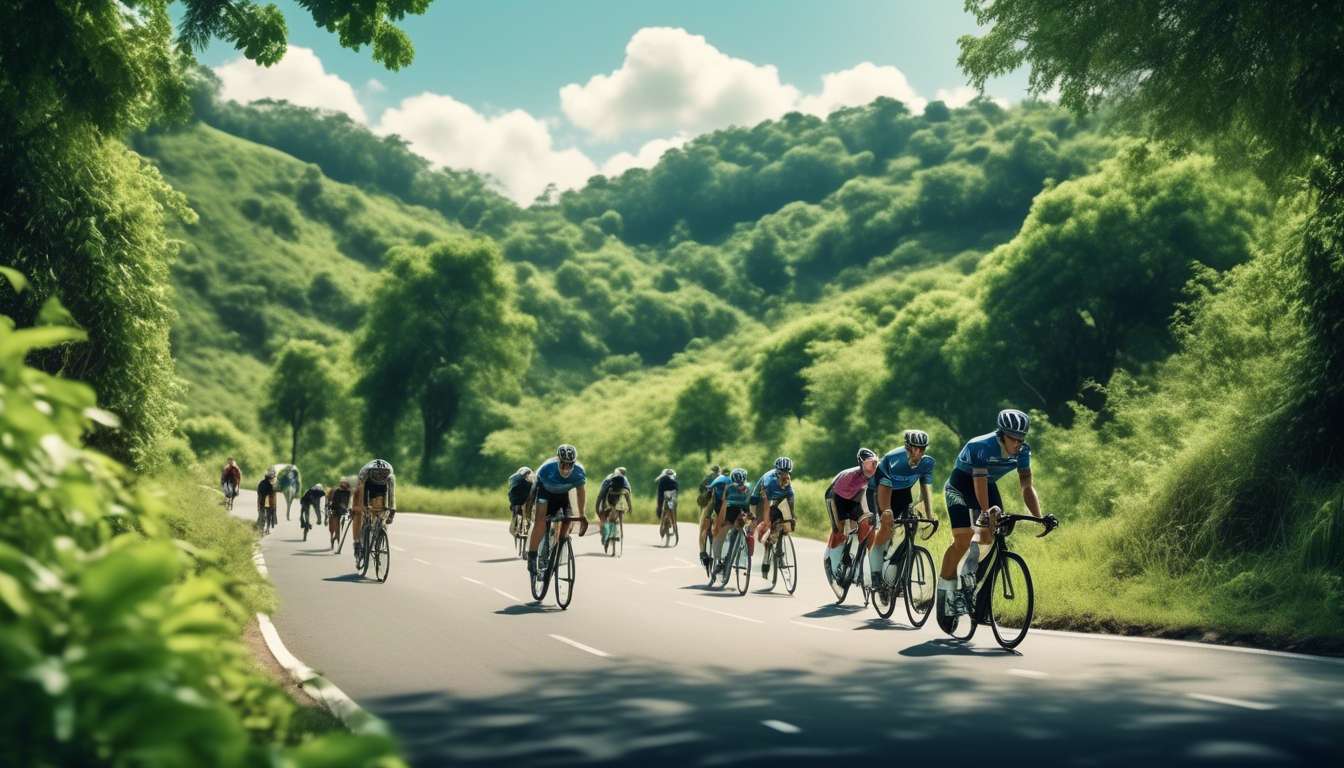As passionate cyclists, we know firsthand the thrill of the ride and the pursuit of victory. There’s nothing quite like the rush of wind on our faces and the satisfaction of crossing the finish line.
However, we also understand that success in cycling isn’t just about pedaling harder—it’s about strategy, preparation, and making the most of every opportunity. In this article, we aim to share our collective wisdom and experience to help you maximize your wins with some of the best cycling tips out there.
From understanding the nuances of nicer odds to optimizing your training routine, we’ve compiled insights and strategies that have proven effective for us on the road. Whether you’re a seasoned racer or a weekend warrior, these tips are designed to give you the edge you need to improve your performance and enjoy every moment on two wheels.
Let’s gear up and ride towards victory together!
Key Tips for Cycling Success:
-
Understand the Terrain:
- Analyze the course in advance.
- Note areas where you can conserve energy and where to push harder.
-
Optimize Your Training Routine:
- Incorporate interval training to build stamina and speed.
- Don’t neglect rest days to allow your body to recover and strengthen.
-
Focus on Nutrition:
- Maintain a balanced diet rich in carbohydrates and proteins.
- Stay hydrated before, during, and after rides.
-
Master Your Gear:
- Ensure your bike is well-maintained and suited to your body and riding style.
- Practice shifting gears efficiently to maintain momentum.
-
Develop a Winning Mindset:
- Set achievable goals for each ride.
- Visualize success and stay positive, even in challenging conditions.
By following these strategies, you can enhance your cycling experience and increase your chances of achieving your goals. Enjoy the ride and embrace the journey towards becoming a better cyclist!
Analyze Course Terrain
Understanding the course terrain is crucial for predicting cycling outcomes and optimizing betting strategies. As a community of cycling enthusiasts, we know that the terrain can make or break a rider’s performance. When analyzing these courses, consider everything from steep climbs to flat stretches. These elements influence race dynamics and can provide a strategic edge in nicer odds cycling. By studying the course profile, we can better anticipate which cyclists have the advantage, helping us make informed bets.
Let’s dive deeper into how terrain impacts the race:
-
Climbs:
- Favor climbers, riders who excel in steep, uphill sections.
-
Flat Terrains:
- Cater to sprinters who thrive on speed and less resistance.
Additional Considerations:
- Weather Conditions: These can transform an easy ride into a challenging battle, impacting performance and outcomes.
By gathering and analyzing this information, we not only enhance our understanding but also strengthen our connection with fellow fans. Together, we can enjoy the thrill of the race and make smarter betting decisions.
Interval Training Benefits
Interval training significantly boosts a cyclist’s endurance and speed, making it an essential component of any training regimen. By incorporating short bursts of high-intensity efforts followed by rest or low-intensity periods, cyclists can effectively simulate race conditions and prepare their bodies for the unpredictable nature of cycling competitions.
The camaraderie felt during these challenging sessions not only strengthens physical abilities but also fosters a sense of unity and shared purpose.
Embracing interval training sets cyclists up for success and improves their chances in cycling events. The collective progress becomes evident through:
- Tackling hills with newfound vigor
- Sprinting past competitors with ease
These sessions aren’t just about physical gains. They’re about building resilience and mental toughness, essential traits when the going gets tough.
Commitment to this training approach means every interval brings cyclists closer to their personal best and strengthens their bond as a team.
Balanced Nutrition Importance
Proper nutrition plays a pivotal role in maximizing cycling performance and recovery. As part of our cycling community, balanced nutrition is not just about fueling our rides but also about enhancing our camaraderie and shared victories.
When we prioritize nutritious meals, we ensure we have the energy and stamina to tackle challenging routes together.
Key Elements of Cycling Nutrition:
- Carbohydrates: Provide energy to sustain long rides.
- Proteins: Essential for muscle repair and recovery.
- Healthy Fats: Support overall energy balance and endurance.
Fueling our bodies with the right balance can be the difference between feeling drained or powerful during rides. Sharing tips on meal prep and favorite snacks brings us closer, creating a support system that extends beyond the bike.
Post-Ride Recovery:
- Protein-Rich Snacks: Help repair muscles.
- Hydration: Maintains focus and endurance.
In our pursuit of better performance, balanced nutrition becomes a shared ritual. Let’s continue to prioritize our health, ensuring that we face every challenge with strength and unity.
Gear Maintenance Essentials
Every cyclist knows the importance of regularly maintaining our gear to ensure safety and optimal performance on every ride. In our cycling community, we’re not just riding solo; we’re sharing tips and supporting each other to keep those wheels turning smoothly. A well-maintained bike gives us better odds of cycling towards success, whether we’re aiming for a casual weekend ride or tackling a challenging race.
Tire Maintenance:
- Check tire pressure before each ride to avoid flats and improve traction.
- This is a small step that makes a big difference.
Chain Maintenance:
- Keep the chain clean and well-lubricated to reduce wear.
- This improves pedaling efficiency.
Brake Inspection:
- Regularly inspect brakes to ensure they are responsive.
- Responsive brakes are crucial for safety.
Bolt and Screw Check:
- Perform a quick check to ensure all bolts and screws are tight and secure.
By prioritizing these gear maintenance essentials, we’re not just preserving our bikes; we’re enhancing our sense of unity and readiness in cycling.
Goal-Setting Strategies
Setting clear, achievable goals is our compass for navigating the diverse paths of cycling success. When we unite as a community, sharing aspirations and strategies, we create a supportive environment where we all thrive.
Our first step is identifying what we truly want from our cycling journey. Whether it’s conquering a local race or improving endurance, our goals should be specific and realistic. This clarity enhances our cycling experience, guiding us toward success.
Breaking down goals into smaller, manageable milestones is crucial.
- Celebrating each small victory keeps us motivated.
- It reinforces our sense of belonging.
By tracking progress, we ensure our goals remain relevant, adjusting them when necessary to reflect our growth. Encouraging one another, we foster a collective spirit of perseverance and determination.
As we embark on this journey, let’s remember that setting goals isn’t just about reaching the finish line. It’s about the shared experiences and camaraderie we gain along the way.
Visualizing Success Techniques
Visualizing our success in cycling can powerfully transform our mindset and performance. When we picture ourselves conquering the toughest hills or crossing the finish line with our teammates, we’re not just daydreaming—we’re setting the foundation for reality. This mental imagery boosts our confidence and aligns our mind with our physical goals, giving us nicer odds in cycling competitions.
By consistently practicing visualization, we form a mental blueprint of success that guides us through challenges.
Let’s create a vivid mental picture, down to the smallest detail:
- The feel of the bike under us
- The wind against our skin
- The cheers from our fellow cyclists as we reach new milestones
These moments become our motivation, strengthening our bond with the cycling community. Together, we share our visual stories and encourage each other, knowing that every race won first happens in the mind.
By focusing on these visualization techniques, we boost not just individual success, but our collective triumphs.
Recovery and Rest Importance
Adequate recovery and rest are crucial for maintaining our cycling performance and preventing burnout. We all want to be at our best when we hit the road, and taking the time to rest helps us achieve better results and keeps us part of the cycling community we cherish. When we allow our bodies to heal, we increase our chances of staying injury-free, which in turn boosts our morale and sense of belonging.
Incorporating recovery days into our routines can improve our cycling experience. By giving ourselves permission to take a break, we promote:
- Muscle repair
- Mental rejuvenation
Let’s not forget, cycling isn’t just about pushing boundaries; it’s about enjoying the journey with our fellow riders.
Together, we can make rest days enjoyable by:
- Connecting with our cycling group for light activities
- Simply sharing stories over coffee
Embracing rest as a team strengthens our bonds and enhances our collective success, ensuring we all have a great ride ahead.
Hydration Tips for Cyclists
Staying properly hydrated is essential for optimal performance and endurance during our rides. As a community of passionate cyclists, we understand that hydration can make or break our journey towards achieving better cycling results.
Pre-ride Hydration:We should start each ride well-hydrated by sipping water throughout the day before we even hop on our bikes.
During the Ride:
- It’s crucial to drink regularly, even if we’re not feeling thirsty, as our bodies may not always signal dehydration immediately.
- Carry a water bottle or a hydration pack to ensure we have access to fluids when needed.
For Rides Longer Than an Hour:
- Consider replenishing electrolytes lost through sweat with sports drinks or electrolyte tablets.
Post-ride Hydration:
- Remember that rehydrating after a ride aids recovery and sets us up for success in future rides.
By integrating these hydration tips into our routine, we not only boost our performance but also strengthen our bond as a cycling community.
What are some common mistakes beginner cyclists make when trying to improve their odds of winning?
When we start cycling, we often overlook crucial aspects that can boost our chances of winning.
Some common mistakes include:
- Neglecting proper bike maintenance
- Ignoring the importance of nutrition and hydration
- Not focusing on building endurance gradually
By addressing these errors and adopting a well-rounded approach to training, we can enhance our odds of success on the road.
It’s all about learning from our missteps and striving for improvement.
How can mental preparation impact a cyclist’s performance in competitive events?
Mental preparation plays a crucial role in a cyclist’s performance in competitive events. Our mindset influences our focus, confidence, and ability to handle pressure.
By staying positive, visualizing success, and managing pre-race nerves, we can enhance our performance on race day.
Key strategies for mental preparation include:
-
Setting Realistic Goals
- Define clear, achievable objectives for each race.
- Break larger goals into smaller, manageable tasks.
-
Practicing Mindfulness
- Engage in regular meditation or deep-breathing exercises.
- Stay present and focused during training and competitions.
-
Using Mental Strategies
- Visualize successful race scenarios.
- Develop a positive inner dialogue to boost confidence.
- Practice stress-management techniques to handle pre-race anxiety.
By incorporating these strategies, cyclists can overcome challenges and perform at their best when it matters most.
What role does technology, such as cycling apps or GPS devices, play in enhancing a cyclist’s training regimen?
Technology in Cycling Training
Technology, such as cycling apps and GPS devices, greatly enhances our training regimen.
Key Benefits:
- Performance Tracking: These tools allow us to keep track of our performance.
- Route Mapping: We can map out routes with ease.
- Data Analysis: They enable us to analyze data for improvement.
Real-Time Feedback:
- Provides immediate insights.
- Helps adjust pace and effort levels during rides.
Training Optimization:
With these advancements, we can:
- Fine-tune our training plans.
- Set specific goals.
- Measure our progress accurately.
Ultimately, these technological tools lead to better performance on the road.
Conclusion
Maximize your wins by incorporating these tips into your cycling routine:
-
Analyze the Terrain
- Understand the route you will be cycling.
- Adapt your strategy according to the terrain, whether it’s flat, hilly, or mixed.
-
Embrace Interval Training
- Integrate short bursts of intense effort followed by rest periods.
- Improve both speed and endurance through consistent interval training.
-
Fuel Your Body Right
- Consume a balanced diet rich in carbohydrates, proteins, and fats.
- Plan your meals and snacks around your riding schedule to optimize energy levels.
-
Maintain Your Gear
- Regularly check and service your bicycle to ensure it is in perfect working condition.
- Pay attention to tire pressure, chain lubrication, and brake functionality.
-
Set Achievable Goals
- Establish clear, realistic objectives for your cycling progress.
- Track your achievements and adjust goals as needed to stay motivated.
-
Visualize Success
- Spend time mentally rehearsing successful rides and overcoming challenges.
- Enhance your focus and confidence through visualization techniques.
-
Prioritize Rest
- Allow your body adequate time to recover between rides.
- Incorporate rest days into your schedule to prevent burnout and injury.
-
Stay Hydrated
- Drink plenty of water before, during, and after cycling to maintain optimal hydration levels.
- Consider using electrolyte drinks for longer rides.
By implementing these strategies, you’ll not only improve your performance but also enhance your overall cycling experience.
So, pedal on and make the most out of every ride!




